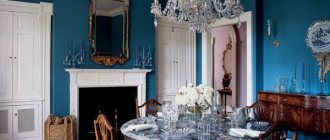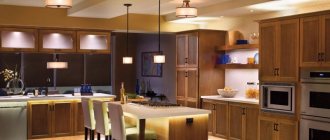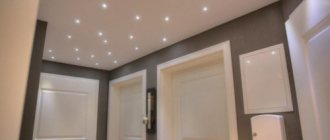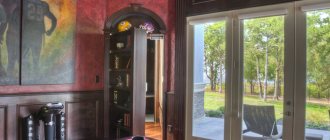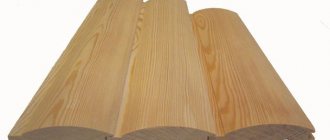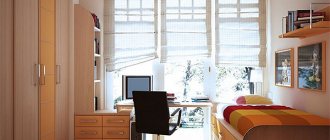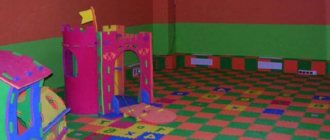General recommendations
Lighting in a room with low ceilings should be sufficient. Twilight and corners in the shadows will make it closer. It is important to think through not only the general level, but also the location of light sources. Rooms with low ceilings are elongated. In such cases, a central chandelier is not enough; additional light sources will be needed further away from the main one.
Several equivalent devices distributed over the ceiling area also look good. For main lighting, it is better to choose diffused light that spreads at a wider angle. Narrow beams are used to place accents.
There is one more secret. Light directed at the ceiling is reflected and visually stretches the room upward. In this type, not only a chandelier is chosen, but also sconces, floor lamps, etc. The effect is especially pronounced with a glossy finish.
To create a harmonious environment, it is important to consider color temperature. According to the designers' recommendations, all light sources in the room should be the same. Only accent lighting can have a different color temperature.
Warm lighting is more appropriate in the bedroom, creating a calm, relaxing environment, while neutral lighting is more appropriate in the living room and kitchen. For the office, a cold one that gets you in the mood for work is best.
Tips for choosing a chandelier for rooms with low ceilings
When choosing chandeliers, you should pay attention to the shape of the shades. It should not be elongated and wide. Because of this, the space becomes even smaller, the ceiling looks very low.
The visual effects will depend on where the chandelier is located.
Visually, you can achieve different effects when dealing with a narrow and long lampshade. Everything will depend on the place where the chandelier is attached. Ceiling pressed models are considered the most suitable.
There should be no additional decor or hanging decor on them. It is better to purchase strict and elongated models of lampshades. The most suitable color is metallic. Mirror products look impressive, because they are ideal for any small rooms with low ceilings. Since they reflect light, it is possible to achieve a significant increase in space. This is an ideal solution for lamps that are too bright.
In order not to run around looking for certain parts, it is better to buy lamps or chandeliers from domestic manufacturers; we must not forget about the warranty card.
Suitable lighting for low ceilings
There are many models suitable for low rooms, for every taste and budget. Let us consider in detail the main types.
Compact ceiling chandeliers
This type of appliance is often chosen for the living room. It not only illuminates, but decorates and unifies the interior. To choose a model suitable for a low room, follow several rules.
Transparent or white shades are best; you can use pastel shades. Such lampshades do not limit the light flow and do not stand out too much against the background of the ceiling.
Bright colors, especially contrasting ones, are not suitable; they reduce the effective power and attract unnecessary attention.
One of the limitations when choosing a chandelier for low ceilings is the height of the model. In order to be able to walk freely below, you will need at least 2 meters from the floor (preferably 2.2-2.3 m). Subtracting this figure from the size of the room, you get the maximum height of the lighting fixture.
The lowest point is taken into account: the edge of the lampshade, suspension, etc. If the room is not enough even for a compact chandelier, you can place it above a table, bar, cabinet, etc. This way the lamp will not interfere with the passage.
The shape of a chandelier for a living room with a low ceiling will differ from the classic one. Flat-format models located horizontally (as if pressed to the ceiling) fit these restrictions. The design may include several horns or one dome-shaped lampshade. Models with a flat base and hangers are suitable, as long as they are not too long.
For an elongated room, the best choice would be two small chandeliers located at a distance from one another. They are also called companion chandeliers.
LED panels and overhead ceiling lights
Such devices are small in thickness (up to 1-1.5 cm), so they are suitable even for the lowest rooms. The top is covered with a matte plastic shade. The lighting is diffused and uniform, comfortable for the eyes.
The shapes are varied: circle, square, rectangle, etc. Models also differ in size, from modest to quite large. Design options can have complex outlines or consist of several figures.
The panels are installed on various types of ceilings. In suspended or tensioned ones they are recessed in whole or in part.
Some models have additional side lighting. With it, the upper part of the room (ceiling, baseboard) will not be in the shadow. But if the overlap is uneven, all roughness and imperfections will be noticeable.
Modern diode devices make it possible to adjust the brightness and color temperature of lighting, turn it on remotely or by timer, and configure various modes. For control, use a remote control or an application on a smartphone.
Spotlights and spots
These devices are used in combination with a chandelier or separately, combined into groups. The main disadvantage is the narrowly focused light flux, so the devices are placed at a short distance from each other (about a meter).
Based on the type of design, spotlights are divided into recessed and surface-mounted. They differ in appearance and installation principle.
Recessed lamps are installed in a plasterboard or suspended ceiling and almost do not protrude beyond the surface. Such devices are practically invisible when turned off. But installation requires a small space between the ceiling and the cladding (5-7 cm), and for low rooms this is not the best solution, as it reduces the height. But sometimes in part of the room, for example, along the perimeter or against one wall, a second tier is made. Then you can build spotlights into it.
Overhead models can be installed on any type of ceiling and do not require hidden space. Such lamps are more noticeable, but the variety of designs allows you to match them to different interior styles. Round, cubic, cylindrical devices are produced, laconic and decorated, for example, with crystal pendants. There are black, white, colored, metallic, etc.
Important! For low ceilings, it is better to choose lamps that are small in height and dim, preferably in the color of the surface (usually white).
Spots with a built-in hinge are convenient, allowing you to direct the light to the desired area. Functionally, one such device replaces several at once. But for small rooms, neatness and the absence of unnecessary objects are especially important. By type, spots can be overhead or built-in.
Track lighting systems
Such devices are suitable for modern interiors. They are a 2 or 3 meter long tire on which several spots are located. In this case, each turns separately and can move freely along the track. The structure is attached to the ceiling or suspended on cables. For low rooms, choose the first option.
The tires can be combined into a longer line, angle, square, cross, etc. For this, special connectors are used. Inside the base there is a power supply to which the lamps are connected.
Bulbs of different wattages are used, with concentrated or diffuse flux (with or without a reflector inside). Dim options with a directional beam are suitable for accent lighting of decorative items. And powerful devices with a wider beam angle are successfully used as the main light source.
Peculiarities! Some models allow you to turn on spots in groups, rather than all at once. This is how the light intensity is adjusted. As a result, track systems are very easy to use.
LED lights
Not only light bulbs, but also LED strips are widely used. They are a flexible narrow strip with LEDs that come in different powers; you can choose the color of the glow (there are options with the ability to change the shade using the remote control). The tape is easy to install - just remove the protective layer and stick it to the wall or ceiling. As with overhead devices, the brightness and color of the backlight are adjustable.
LED strip can be used as full lighting or additional decorative lighting. There are many design options. You can make light lines, floating ceilings or curtains (placed behind the cornice), emphasize the second tier, etc. These techniques create the effect of greater height.
One of the most practical solutions is a luminous ceiling. In this case, the entire surface turns into one large lamp, which looks very impressive and visually raises the height. To create such a design, LED strips are placed on the ceiling and covered with a translucent stretch fabric or frosted glass panels. When the light is turned off, the surface looks like a regular ceiling.
Attention! When choosing an LED strip, you need to take into account that it operates on a power of 12, 24 or 220 volts. The first two options save electricity, but you will need a step-down transformer to connect. It is better to think in advance where to hide it.
What lighting fixtures cannot be used with low ceilings?
Some lighting fixtures will make the room even lower. These are large chandeliers, especially those with a long pendant, or bulky crystal models. Sometimes they don't even allow you to walk around the room freely.
Any lamps for low ceilings should not be overly massive. Bright colors, especially those that contrast with each other or with the ceiling, are undesirable. Large sizes and long suspensions make lighting fixtures completely unsuitable for low rooms.
Optimal lighting for low wooden houses
For country cottages where people live all year round, the recommendations remain the same as for an apartment. For lighting in a wooden house with low ceilings, flat or dome-shaped devices, transparent, white or pale tones are optimal. It is important to choose lighting of sufficient power that does not leave shadows in the corners, but is not too bright.
If the cottage is used only for seasonal residence, additional requirements arise. In winter, the heating does not work constantly, so the lamp must withstand temperature changes. If the device deteriorates, the wiring may also suffer, and in the worst case, a fire will start. LEDs tolerate cold well.
Sometimes leaks occur in country houses due to damage to the roof. To prevent damage to the lighting fixture, choose moisture-resistant models.
Residential attics require a special approach: not all lamps look good on a sloping ceiling. It is better to abandon the chandelier in favor of panel, surface-mounted or built-in devices.
In terms of design, it is advisable to choose simple models, without elaborate decor, and not conspicuous. Such devices do not attract undue attention, which is important when the house is left unattended.
Low ceilings are not a death sentence for design. And such rooms can look stylish, bright and comfortable. You just need to pay more attention to the choice of lighting fixtures.
Main selection criteria
Let's try to determine what you need to pay attention to when selecting a lighting fixture for such a living room and what nuances will be insignificant. Not only the illumination of the room, but also how it will be perceived visually will depend on how correctly this lighting device is selected.
- Suspension design. Here you should definitely give preference to fastening directly to the ceiling rather than to a suspension. Visually, a suspended chandelier will take up too much space and you can accidentally touch it with your head or hands.
- Lamp power. For tension coatings, too powerful lamps will be a death sentence - they will melt the coating. Panel coverings can also be sensitive to heat, although they are not used too often in living rooms. If you have ordinary concrete ceilings, you should also pay attention to this parameter - dark spots may appear on the surface from the rising flow of warm air. Therefore, it is better to choose lamps of medium power or be limited to the power that the installed coating allows.
- Direction of light. The horns should ideally point upward so that the reflected light creates uniform, diffuse illumination. However, not all types of coatings allow the use of such chandelier models. Therefore, it is better to use those models in which the horns point to the sides or use LED lamps that do not heat up during operation.
At the same time, appearance should not be the determining factor in the choice. Of course, it is very important how the chandelier chosen for a room with a low ceiling will look, but its appearance should take a back seat in importance.
